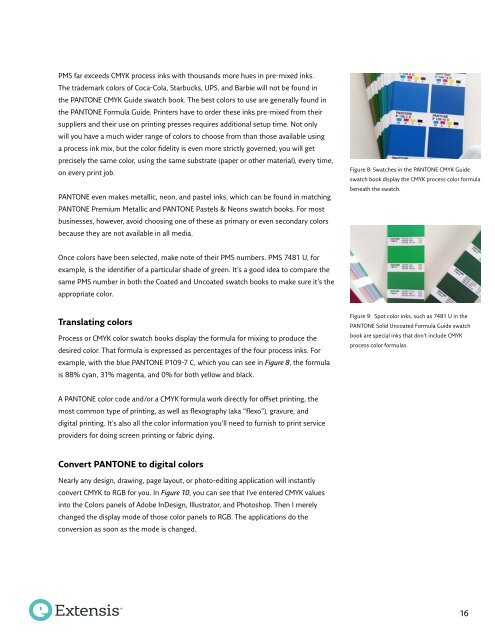You also want an ePaper? Increase the reach of your titles
YUMPU automatically turns print PDFs into web optimized ePapers that Google loves.
PMS far exceeds CMYK process inks with thousands more hues in pre-mixed inks.<br />
The trademark colors of Coca-Cola, Starbucks, UPS, and Barbie will not be found in<br />
the PANTONE CMYK <strong>Guide</strong> swatch book. The best colors to use are generally found in<br />
the PANTONE Formula <strong>Guide</strong>. Printers have to order these inks pre-mixed from their<br />
suppliers and their use on printing presses requires additional setup time. Not only<br />
will you have a much wider range of colors to choose from than those available using<br />
a process ink mix, but the color fidelity is even more strictly governed; you will get<br />
precisely the same color, using the same substrate (paper or other material), every time,<br />
on every print job.<br />
PANTONE even makes metallic, neon, and pastel inks, which can be found in matching<br />
PANTONE Premium Metallic and PANTONE Pastels & Neons swatch books. For most<br />
businesses, however, avoid choosing one of these as primary or even secondary colors<br />
because they are not available in all media.<br />
Figure 8: Swatches in the PANTONE CMYK <strong>Guide</strong><br />
swatch book display the CMYK process color formula<br />
beneath the swatch.<br />
Once colors have been selected, make note of their PMS numbers. PMS 7481 U, for<br />
example, is the identifier of a particular shade of green. It’s a good idea to compare the<br />
same PMS number in both the Coated and Uncoated swatch books to make sure it’s the<br />
appropriate color.<br />
Translating colors<br />
Process or CMYK color swatch books display the formula for mixing to produce the<br />
desired color. That formula is expressed as percentages of the four process inks. For<br />
example, with the blue PANTONE P109-7 C, which you can see in Figure 8, the formula<br />
is 88% cyan, 31% magenta, and 0% for both yellow and black.<br />
Figure 9: Spot color inks, such as 7481 U in the<br />
PANTONE Solid Uncoated Formula <strong>Guide</strong> swatch<br />
book are special inks that don’t include CMYK<br />
process color formulas.<br />
A PANTONE color code and/or a CMYK formula work directly for offset printing, the<br />
most common type of printing, as well as flexography (aka “flexo”), gravure, and<br />
digital printing. It’s also all the color information you’ll need to furnish to print service<br />
providers for doing screen printing or fabric dying.<br />
Convert PANTONE to digital colors<br />
Nearly any design, drawing, page layout, or photo-editing application will instantly<br />
convert CMYK to RGB for you. In Figure 10, you can see that I’ve entered CMYK values<br />
into the Colors panels of Adobe InDesign, Illustrator, and Photoshop. Then I merely<br />
changed the display mode of those color panels to RGB. The applications do the<br />
conversion as soon as the mode is changed.<br />
16


